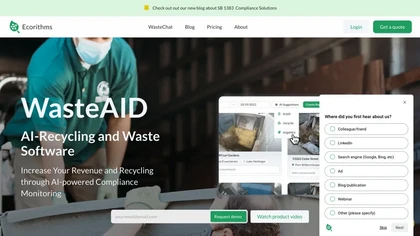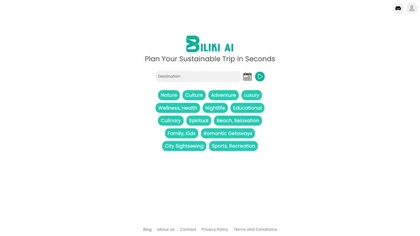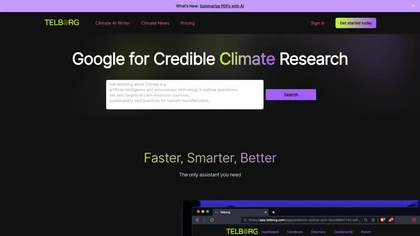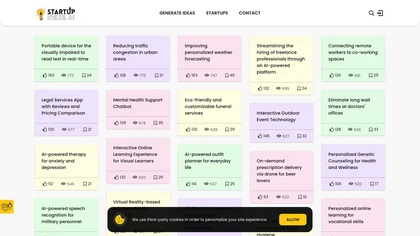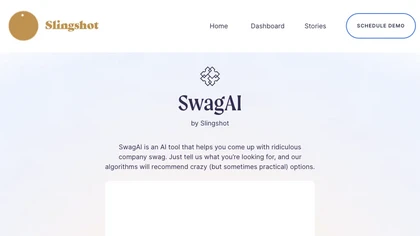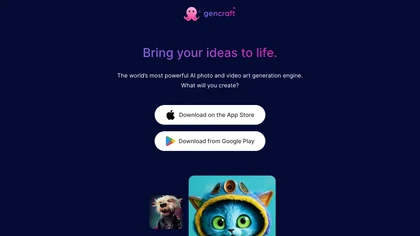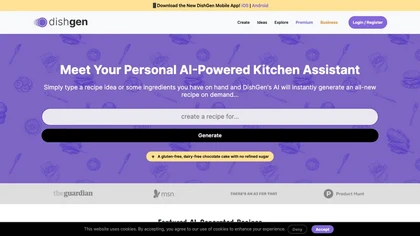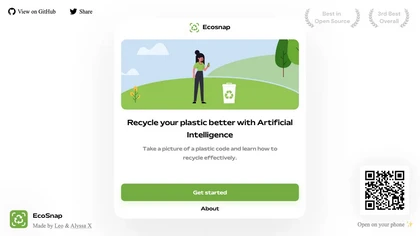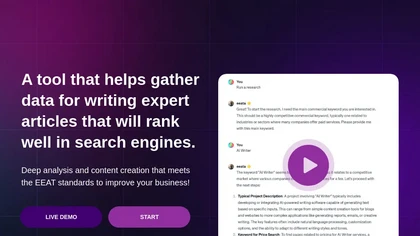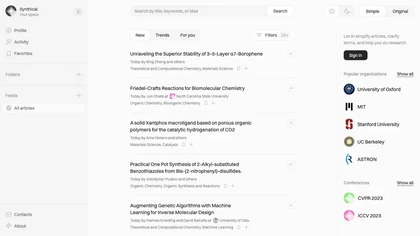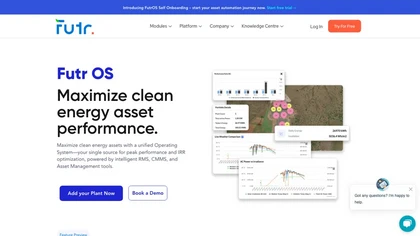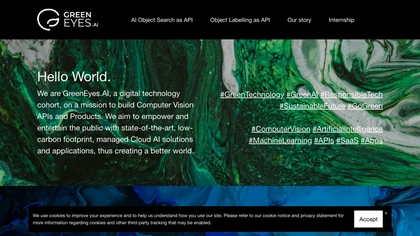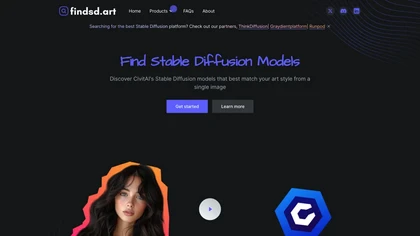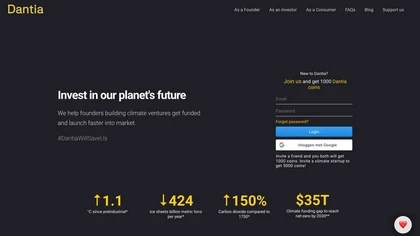AI use cases for Environmental conservation
Generative AI can be applied in various applications for environmental conservation. Here are some examples to explore below for inspiration with AI tools to get you started with using AI in environmental conservation.
🛠️ 70 AI tools for Environmental conservation
Explore a dynamic list of some of the most popular tools to get you started with various AI use cases and applications for Environmental conservation to streamline your workflows and productivity today.
Tsquare features
- Upload design sketches or 3D models
- Fine-tuning styles using AI
- Concepts to detailed designs transformation
- Easy iteration and re-editing
- Version control features
- Team work collaboration features
Green Suggest features
- AI-powered upcycling suggestions
- Personalized upcycling ideas based on user preferences
- Vast database of relevant content and DIY tutorials
- Reduction of textile waste
- Promotion of eco-conscious fashion choices
LookBook features
- Sustainable outfits
- Tailored to individual tastes
- User-friendly interface
- Virtual models
- Step-by-step guidance
WasteAID features
- Automatic route auditing
- Integration with existing systems
- Audit over 400k generators and 1m+ pickups
- Detect overflow incidents and identify contamination
- Tracking commercial account compliance
Biliki AI features
- Custom itineraries generation
- Sustainable travel plans
Telborg features
- Summarization of PDFs
- Custom knowledge base for insightful answers
- Generation of fact-filled first drafts on climate topics
- Structured and accurate inputs for presentations and reports
- Blog section for staying informed on latest climate topics
Greenifs.ai features
- Detect greenwashing errors
- Ensure compliance with green marketing guidelines
- Check social media content for compliance with region-specific regulations
- Offer targeted corrections and recommendations
- Help avoid legal issues related to environmental laws
🔥
Create your account, save tools & get personal recommendations
Receive a weekly digest of our handpicked top tools.
Unsubscribe anytime
Proxy features
- Energy-efficient upgrades
- Carbon footprint reduction
- Utility bill savings
- Tax credits and rebates
- Energy efficiency analytics
Faircado features
- Product search across multiple categories
- Integration into browsing experience
- Automatic search for pre-owned products
- Support for second-hand items
- Assistance in finding refurbished alternatives
Silly Robot Cards features
- Design selection
- Photo upload
- Greeting card selection
- Personalization
- Shipping options
Startup Ideas AI features
- Wide array of startup ideas generation
- Streamlining of hiring freelance professionals
- Connecting remote workers with co-working spaces
- Suggestions for eco-friendly customizable funeral services
- Real-time text reading for the visually impaired
ClothingAI features
- Create unique clothing designs
- Experiment with color schemes
- Customize garments with various details
- Receive up to nine design renders
- Easily iterate on designs or share with others
SwagAI features
- Generates trendy outfits
- Supports anti-poaching and wildlife conservation organizations
- Visit tritech labs and chat with support team
Dreamlife features
- Design idea generation
- Home shopping
- Renovation task streamlining
- Professional networking
Gensbot
5Gensbot features
- Instant creation of personalized goods
- Generation of customized catalog based on user preferences
- Sustainability focus in AI designs
- Local production to minimize carbon emissions
- Token rewards system for unlocking future designs and exclusive offers
ScrappyChef features
- Recipe generation
- Leftover ingredient conversion
- Subscription service
- Paid service
- Food waste reduction
Gencraft features
- Video generation
- Text prompts
- Visual categories
- Brand showcasing
- Creativity elevation
DishGen features
- Recipe generation based on input ingredients and dietary preferences
- Generation of seven different recipe ideas based on ingredients
- Custom-tailored recipes for vegan, vegetarian, and gluten-free options
- Fast recipe generation in seconds
- Efficient utilization of leftover ingredients
Ecosnap features
- Visual recognition
- Plastic codes
- Teaching effective recycling
- Open source code
- Phone accessibility
edu720 features
- AI-powered content
- Powerful analytics
- Nanolearning capabilities
- Mobile learning capabilities
- Support for various industries
PenPal features
- Digital NFC business card sharing
- AI clone for interactive virtual interactions
- Dashboard insights on card usage
- Custom engraving options
- Authentic self representation by AI clone
Strand Store features
- AI-generated themes for fashion designs
- 10 attempts for theme selection
- Customization of garments
- Innovation in sustainable fashion
- Email requirement for checkout
Mymealplan features
- Generates personalized meal plans
- Curates a list of the best recipes from the web
- Easy-to-use app
- Caters to various dietary preferences
- Provides grocery list for easy shopping
MealMate
5MealMate features
- Plan meals
- Tailor dietary preferences
- Consider budget
- Adjust for time constraints
Synthical: Science features
- Simple searches and filters
- Organic chemistry reactions exploration
- Inverse molecular design using genetic algorithms and machine learning
- Investigation of sustainable water disinfection technologies
- Delving into photochemical reactions and solid electrolyte interphase investigations
Saara.io features
- Focus on solving common industry challenges
- Reduce operational costs
- Analyzing customer data for personalized offers and improved shopping experience
FutrOS features
- Unified operating system
- Warranty management
- Digital twin technology
- Automated performance insights
- Real-time alerts
GreenEyes.AI features
- Object search API
- Object labeling API
- Fast and reliable image recognition technology
- Supports up to 80 object classes
- Scalability on demand
Leftovers AI features
- Recipe generation based on dietary preferences and nutritional goals
- Personalized meal planner for customized meal plans
- Nutritional intake tracking
- Accommodation of special diets such as gluten-free, vegan, and vegetarian
- Saving recipes in a personal cookbook for easy access and organization
CourseMind features
- Course creation
- Content creation tools
- Marketing tools
- Email automation
- Landing page builders
Resleeve.ai features
- Design fashion products
- Photoshoots
- Effortless design process
- Create endless variations to meet demands
- Transform the design process
Reform features
- Modular building blocks for customized solutions
- State-of-the-art multimodal AI models for logistics documentation
- Automation of data capture for various documents
- Seamless integration with universal transportation management systems (TMS) through a universal API
- Embeddable customer dashboards for real-time data insights
FoodZilla.io features
- Recipe builder
- Meal planning system
- Nutrition reports
- Mobile app
- Secure messaging
ContentCal features
- Generating a content calendar
- Suggesting content ideas
- Creating a content strategy
- Early access subscription
HomeDesignsAI features
- Get new interior redesign ideas
- Get new exterior redesign ideas
- Get new garden redesign ideas
- Use 40+ different design styles
Savey Meal-Bot features
- Powered by OpenAI technology
- Utilizes ChatGPT for creating unique recipes
- Combines generative AI with human-reviewed suggestions
- Focuses on minimizing food waste
- Suggests new ways to repurpose leftovers
AI Design Training features
- Virtual staging
- Upcale images
- Convert sketches to realistic renderings
- Expert prompts
- Incorporating AI workflows
MyFit AI features
- Program generation
- Meal plan generation
- Saving programs
- Input personal data
VEG3 features
- Marketing campaign creation
- Revenue increase
- Animal save
- Free trial
- Demo
A.I Meal Planner features
- Generate personalized monthly meal plans
- Access pre-designed low fodmap meal plans including free 3-day and 7-day plan
- Consider specific dietary needs to create customized meal plans
- Provide information on gut health and assist users in leading a healthy lifestyle
- Offer a variety of low fodmap recipes created by an ai chef
FindSD.art features
- Art style matching with diffusion models
- Single image analysis
- Fast search speed
- Free to use with no hidden fees
- Data privacy guarantee
Cohesive AI features
- Ai editor
- Template creation
- Seo blog generator
- Story generator
- Real-time collaboration
- Text translation
- Image translation
- Language translation
- Marketing
- Sales
- Support
- Personal use
- Fast custom support
Mealpractice features
- Recipe generation
- Ingredient selection
- Nutrition style customization
- Protein selection
- Cuisine style selection
RestoGPT features
- Create customized online ordering platform
- Seamless integration with pos systems, sales platforms, and delivery services
- Automated order management, sales, and deliveries
- Efficient online ordering experience for customers
- Simplify online ordering process
Outfits AI features
- Generate outfits
- Recommend outfits
- Create outfit plans
- Suggest accessories
- Provide style advice
GeniePM features
- Product requirements
- User stories
- Use cases
Design Sense features
- Generation of various design styles
- Upload images of existing rooms for restyling
- Exploration and visualization of redesigned spaces through photos and videos
- Access to different render styles
- Offering a Pro account for additional features
FolioProjects features
- AI project management assistant
- Data-rich dashboards for analysis
- Project portfolio management workflow
- Enterprise asset management life cycle support
- Predictive, prescriptive, and generative AI capabilities
spatia features
- Create, render, edit, and showcase designs directly in the browser
- Support for landscape design, kitchen design, architecture design, and AI design agent features
- Efficiently generate designs
- High-quality renderings and client presentations
- 24/7 customer support for personalized design creations
Paintit.ai features
- AI-driven interior design generator
- Refill the space
- Furniture recognitions
- Commercial use license
- Download designs
shoppackage.ai features
- Generative AI rendering tool
- Envision various renovation styles
- Receive recommended material packages
- Select from carefully chosen materials
- User-friendly interface for centralizing the entire process
Rooms features
- Create rooms
- Remix rooms
- Add items
- Customize rooms
- View source code
- Share room links
- Playback on desktop and ios devices
YouGotCooking features
- Recipe suggestion based on available ingredients
- AI-powered personalized recipe recommendations
- Consideration of physical taste in recipe suggestions
- Multilingual support for recipe suggestions
- Utilizes GPT-3 model for enhanced results
Topzeal features
- Product creation
- Sales amplification
- Marketing copy generation
- Full-link data asset deposition management
- Intelligent label classification management
Seazn features
- Generate personalized recipes
- Learns cooking habits
- Updates knowledge
- Filter recipes by meal type and cooking time
- Reduce food waste
Cleanup.pictures features
- Photo editing
- Object removal
- Person removal
- Text removal
- Defect removal
Refabric features
- Design unique wedding dresses
- Customize design options
- Create men's suit designs
- Design swimsuits
Well Me Right features
- AI matching and Health Coach capabilities
- Personalized coaching
- Dietary tracking, nutritional guidance
- Guided meditation sessions
- Adaptive health partner
5-Out features
- Predicting sales
- Optimizing labor
- Optimizing purchasing
- Quick setup
- Getting started
Spring features
- Packaging design inspiration
- Instant artwork generation
- Sharing creation
- Turning ideas into reality
- Unlocking creative potential
GPTs Gallery features
- Access to specialized GPT modules
- Culinary Companion for cooking inspiration
- Weekly Wisdom for daily motivation
- Parenting Ally for valuable parenting tips
- Codemaster for learning coding effortlessly
myfashion AI features
- Generate outfit ideas
- Upload photo
- Select clothing
- Select material
- Select color
Planable features
- Content planning
- Approval workflow
- Collaboration tool
- Centralized platform
- Real-time updates
GenPark features
- Personalized content curation
- Advanced artificial intelligence utilization
- Tailored shopping journey
- Unique shopping experience
- Cutting-edge AI technology
Lebenmaster features
- 3-step process for goal forecasting
- Daily progress logs
- Task management functionality
- Brainstats feature
- Support for executing tasks faster and efficiently
We Are Engineer features
- Education and training focus
- Industry-level partnerships
- Insights from expert engineers
- Support for successful engineering careers
- Workshops, Q&A sessions, and competitions
Dantia features
- AI-powered investment platform
- Connects climate-focused founders with investors, advisors, and early adopters
- Offers personalized opportunities tailored to user preferences and risk appetite
- Facilitates meaningful connections and investment opportunities
- Utilizes AI-driven recommendations for informed decision-making
Savor Smart features
- Personalized meal plans
- Consideration of health conditions and dietary restrictions
- Chatbot integration on WhatsApp
- Blood sugar control and weight loss support
- Contextual reminders throughout the day



